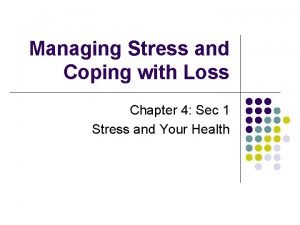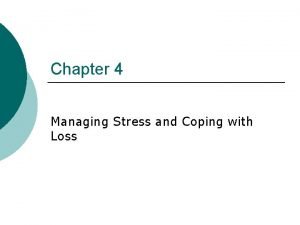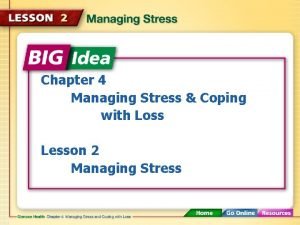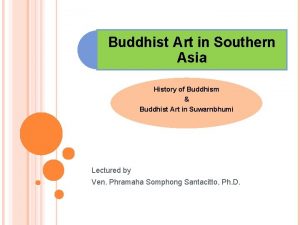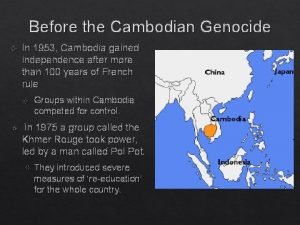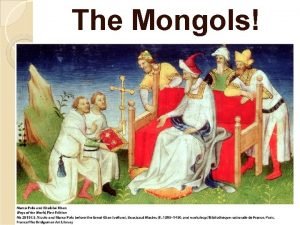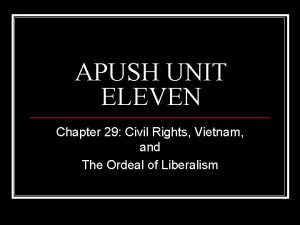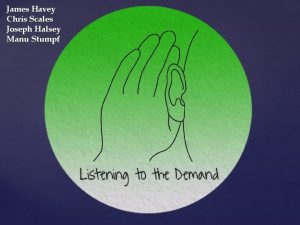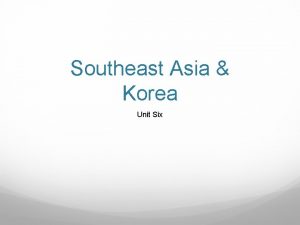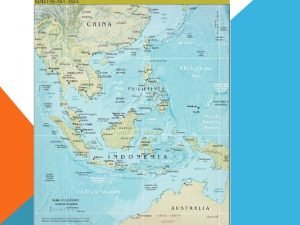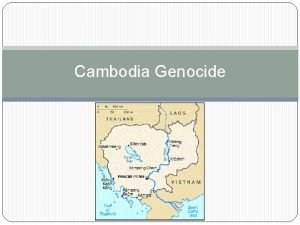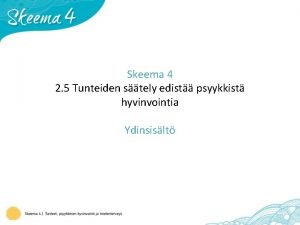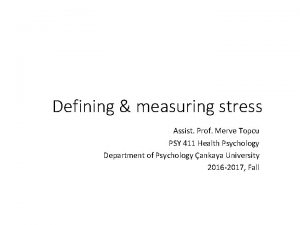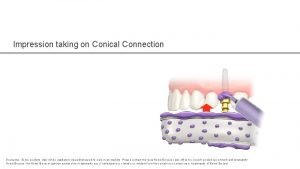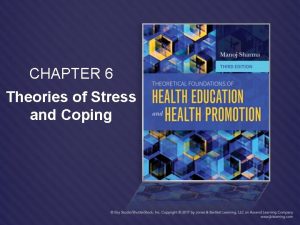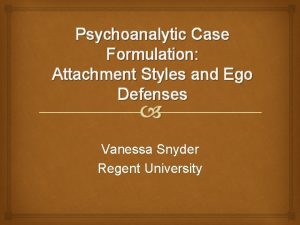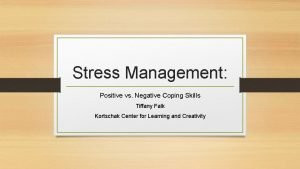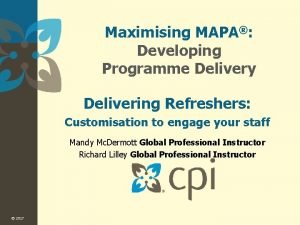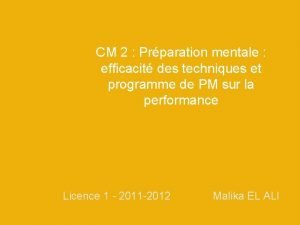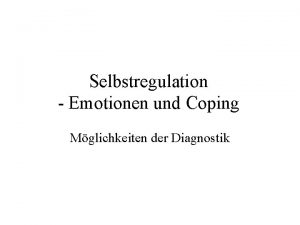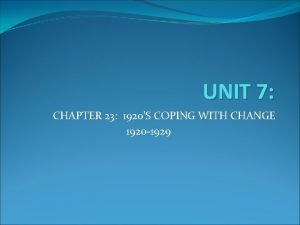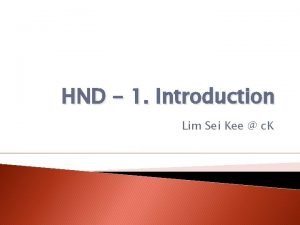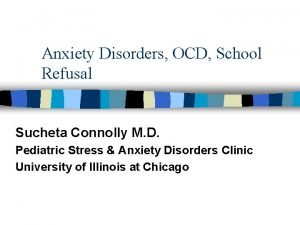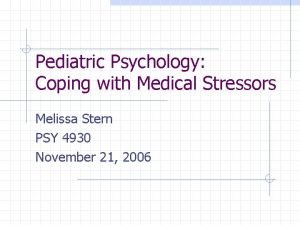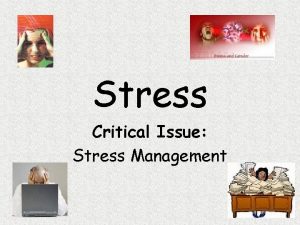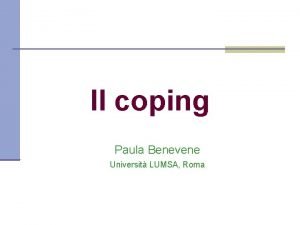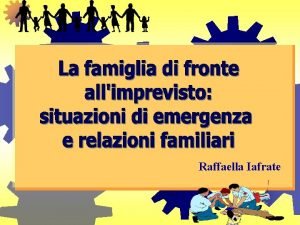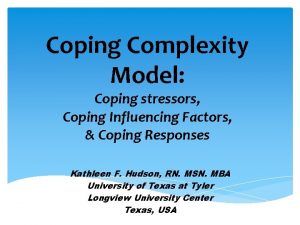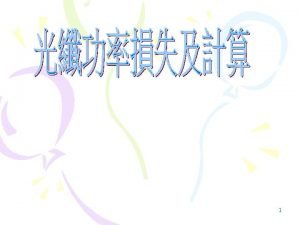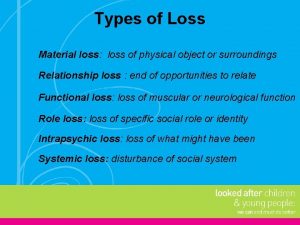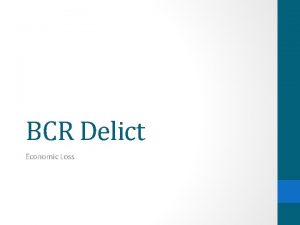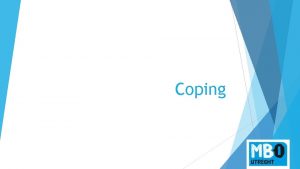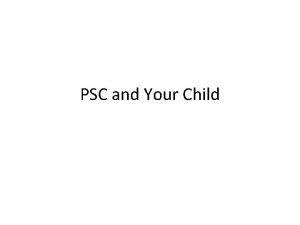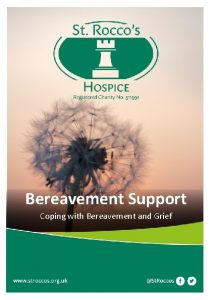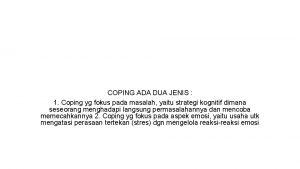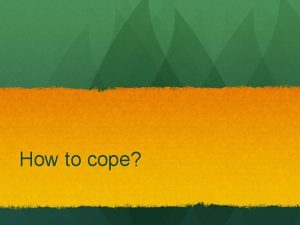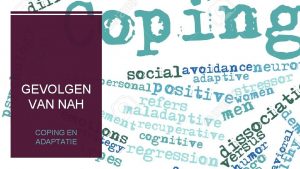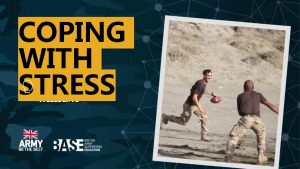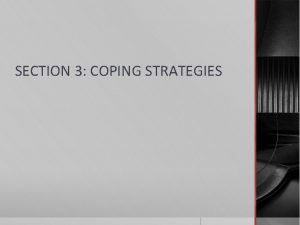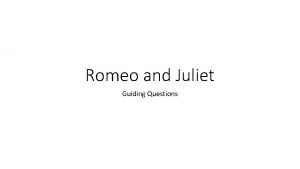COPING WITH LOSS A KHMER PERSPECTIVE ON GUIDING




































- Slides: 36

COPING WITH LOSS: A KHMER PERSPECTIVE ON GUIDING CHILDREN AND ADOLESCENTS UPON THE DEATH OF A LOVED ONE Sekboppa Sor Faculty Sponsor: Professor Carolyn Hames, College of Nursing

Introduction Death is a sensitive subject and many adults are hesitant to explain the process to children. Both adults and children experience loss. Mourning often begins after death. The mourning process serves as an opportunity for individuals to express their emotions through traditions and rituals. Mourning is a way for many individuals to say good -bye. Some traditions and rituals arise from cultural beliefs and values.

Introduction This includes: Ceremonies, customs, and religious traditions Funeral traditions and rituals can sometimes correlate with cultural beliefs and values. One’s culture and social support systems play an important role in the mourning phase because mourning traditions rely on cultural beliefs and values.

What is a significant loss? Losses are experienced by everyone in different ways. The significance is determined by those who experience the loss. Kinds of losses: (1) death of a special person(s), (2) separation or divorce of parents, (3) death of a pet, (4) termination of a relationship (a break-up), (5) diagnosis of a terminal illness. Actual loss, potential loss, anticipatory loss

Honors Project Idea My honors project involved the creation of a fictional children’s book designed to help children and adolescents learn how to cope with the passing of a parent. The book was also designed to help educate readers on Khmer funeral traditions/rituals. The book’s main character was to be a young Khmer-American girl who must learn to cope with the loss of her parents (with special emphasis on the loss of her mother to cancer). The book is to be written for late school-age children (ages nine- twelve years-old).

Personal Significance of Project The story of the young Khmer-American girl will reflect my personal experiences and the losses I have endured. I also grew up in a bicultural background much like the main character of the book. Illustrations and pictures were to be used to help readers visualize Khmer culture and the elaborate ceremonies and rituals that are involved during the period of mourning.

Original Objectives To help children and adolescents understand the importance of recognizing significant losses. To help educate readers on healthy ways of coping with the death of a loved one. To educate readers on Khmer culture and funeral traditions. To help readers understand how gradual the grieving period may be. To help readers recognize that individual growth can be obtained through loss.

Research Elaborate funeral rituals and traditions follow after the death of a special person in the Cambodian (Khmer) culture. Many Cambodians are Theravada Buddhists. Research involved understanding what Theravada Buddhists believe and also understanding the meaning behind traditional funeral rituals and traditions.

Research Cambodian Buddhists monks were asked many questions concerning Cambodian traditions and rituals during the death of a loved one. The location of the temple: Dhammagosnaram Buddhist Temple of Rhode Island, 2870 Plainfield Pike, Cranston, RI 02921.

What is Theravada Buddhism? Theravada Buddhists view death as an end of a cycle and NOT the end of life. The cycle involves stages of birth, illness, old age, death and rebirth. This cycle continues until Nirvana or a state of enlightenment is reached. Buddhist monks play an important role during this time helping to perform blessings during the time of death.

Research Many children’s books about death and dying were read. Focus was on vocabulary level, writing technique and content. These books included: The Death Book by Pernilla Stalfelt Where Do People Go? By Mindy Avra Portnoy Geranium Morning by E. Sandy Powell The Princess in the Kitchen Garden by Annemie & Margriet Heyman A Candle for Grandpa by David Techner & Judith Hirt Manheimer

Research Books on Theravada Buddhism were also read. What Buddhists Believe by K. Sri Dhammananda Good Question, Good Answer by Venerable S. Dhammika

Research on copyright was also made. The following sites gave much information on copyrighting. www. lulu. com & www. copyright. gov The work must eligible in order to be registered with the U. S. Copyright Office On the day of publication, the author or at least one author must be a national or domiciliary of the U. S. or a sovereign authority of a treaty party.

Research Publication must be in the U. S. or in a foreign nation of a treaty party. First publication must be made by United Nation specialized agencies or by an organization in American states. The correct forms must be downloaded and filled out for literary works (www. copyright. gov/forms/formtx. pdf)

Research The forms must be mailed out to: Library of Congress Copyright Office 101 Independence Ave SE Washington, DC 20559 A check must also be sent for the amount of $45 and two copies of the work must also be mailed out. A certificate of registry will be sent out within four months after the form has been received

Research All authors hold copyright to their work after it is written. One does not have to register his/her work. Registration is helpful in the event of a litigation. A licensed work also has legal protection.

Procedures that Followed The actual creation of this work involved much brainstorming in the beginning. Because it was so personal and dear to my heart, it was at first very difficult to write and the task became emotionally draining. I, however, felt it was important that I relived all of these emotions in order to remember and actually put myself in the main character’s place.

Procedures that Followed The FIRST Draft The actual construction of the book took many drafts. The first draft involved me actually writing a diary entry about my own experiences and this draft was originally ten pages. The diary entry was emotionally draining and involved writing about my own experiences with my mother’s death. It started with her diagnosis and ended with my emotional struggles with having to accept my mother’s death.

Procedures that Followed The SECOND Draft The first draft was edited and many pieces of my story were cut out. The story was more focused on my mother’s death and I did not mention my father’s death in the book at all (which was the original plan). What I felt during my mother’s diagnosis of cancer and the months that followed before her operation were not included. The story was reduced to about three pages.

Procedures that Followed The Third Draft The third draft involved actually changing the character’s name and a bit of the dynamics of the story. The character’s age was changed and the vocabulary was also changed for the appropriate reading level. The length of the book, however, was still too long and had to be cut short.

Procedures that Followed The Fourth Draft The 4 th draft involved actually picking and choosing what was to be included in the book. The story’s introduction includes: Introduction to the main character’s cultural background Who the main character is and how old she is The first paragraph also talks about the special person who had died Emotions felt during this tragic time in her life What followed after her special person died

Procedures that Followed The Fourth Draft The 4 th draft also involved putting in more of the research into the work and changing more vocabulary. Pictures were also selected for the book. The original plan included having an actual artist draw the pictures. Instead, personal family photos were used and “photoshopped” to add pastel effects.

Procedures that Followed The Fifth Draft The fifth draft involved actually putting the paragraphs into a draft book form. The book ended up being 13 pages front and back with a total of 22 paragraphs and the last two pages (pg. 12 & 13) were used for glossary terms within the story. All glossary terms were italicized. There were only three pages in the book that did not have any pictures.

The Sixth Draft Each paragraph continued to evolve and some of the paragraphs were even switched around to help create a flow that would help readers understand follow the story. After the main character is introduced, the story flashes back to the day her mom died, how she died and where she died. Instead of concentrating on every single minor detail of my own experiences, I highlighted main events that followed my mother’s death.

The Sixth Draft These main events included details on funeral services, traditions and rituals. The story includes a detailed description of Theravada Buddhism explained in simple terms. The book continues to talk about what role Buddhist monks play during the time of death and what blessings are performed at this time. The book talks about important feelings felt and the physical feelings a child might feel (tummy ache, shortness of breath, chest pain).

The Sixth Draft The book continues to describe other Cambodian funeral rituals and traditions that the main character participates in. Because the main character is a Khmer. American, the book also touches on American funeral customs.

Vocabulary Words Theravada Buddhists: A religion that follows the teaching of Buddha, and the concept that life is a cycle of birth, illness, old age, death, and rebirth. This cycle is affected by Karma. Khmer: The language spoken by Cambodian people. Samsara: A cycle of birth, illness, old age, death and rebirth that Buddhists believe all living things go through before reaching Nirvana: What Buddhists believe to be a place of enlightenment or true bliss.

Vocabulary Words Karma: A deed or action that influences a cause and effect reaction. Karma helps to shape past, present and future experiences and affects Samanera. Bohng sko: A blessing performed by a Buddhist monk at the time of death or after the death of a special person. During this blessing, Buddhist monks chant the Buddhist doctrines in order to pay respect to the Buddha. Bohn psup (bohn): Funeral services held at the home of the deceased until the day of the wake.

Vocabulary Words Samanera: The cycle of birth, illness, old age, death and rebirth that Buddhist believe all living things go through. Booh mook plung: a Cambodian tradition upon the death of a parent that the oldest son becomes ordained as a Buddhist monk. Jol bohn: Donations (money) made to the family of the deceased. Merits are earned for the spirit when donations are made. Kammah: A traditional shawl wrapped across the chest and over one shoulder worn by men and women during bohn.

Vocabulary Words Jaek dey: A shrine built by family members of the deceased where the ashes of the deceased are placed. Pa long: A Cambodian ritual, which involves making an offering of pots, pans, and other items such as sarongs, utensils, and canned foods. These items are packed together and brought to the Buddhists monks in order for them to make an offering to the spirit while the spirit is waiting to be reborn. The monks will be able to use the items themselves after the offering has been made.

Vocabulary Words Saein: In the Khmer language this word is a verb meaning ‘to offer’. Bohn maroy tngai: A memorial service held on the 100 th day after the death of a special person.

The Final Pieces to an ALMOST Finished Product A preface was written after the book layout was created. A title was also created. The book was then bound but was still considered a draft.

Conclusion I had high hopes on finishing this project by the end of the semester. I did not expect this project to be as challenging as I have experienced it to be. Because this fictional book was to be based on my own personal experiences, I thought I would have an easier time writing it. This project has made me come to realize my own feelings about my personal losses and it has also helped me to realize what stage I am at in grieving.

Conclusion The research was also challenging. I’ve learned much on copyrighting and publication. I’ve learned about my own cultural traditions and rituals and how not all of the traditions and rituals that were performed during my mother’s funeral were of Cambodian culture, but of Chinese culture. I’ve also learned much on Buddhism and what Buddhists believe. Unfortunately, I was unable to reach all of my original objectives for the project. I, however, was able to emphasize Khmer funeral traditions/rituals, and the importance of one’s culture.

Conclusion Some obstacles I’ve come across while constructing this book were: Recognizing my own feelings and remembering all of the elaborate funeral rituals my family participated in. Writing at an appropriate school-age level. Working on the flow of the paragraphs. Research on Buddhism. Cropping pieces of the original story out in order to construct a appropriate length book for a school-age child to read. The actual design and layout of the book.

Conclusion This book continues to be a work in progress and I hope to bring it to a different height as it continues to evolve into something great. I plan on continuing to work on the this book with hopes that it will become recognized and read by individuals of all ages and of diverse backgrounds. The creation of this book is one of my greatest accomplishments and I eventually want individuals to benefit from reading it as I have benefitted from creating it.
 Leasiest
Leasiest Chapter 4 managing stress and coping with loss
Chapter 4 managing stress and coping with loss Lesson 3 coping with loss and grief
Lesson 3 coping with loss and grief Chapter 4 managing stress and coping with loss
Chapter 4 managing stress and coping with loss Chapter 4 lesson 2 managing stress
Chapter 4 lesson 2 managing stress Empire khmer
Empire khmer Cambodian genocide blue scarf
Cambodian genocide blue scarf Khmer empire
Khmer empire Bloody sunday apush
Bloody sunday apush Sexkhmer com
Sexkhmer com Six khmer
Six khmer Southeast asia climate
Southeast asia climate Khmer rouge timeline
Khmer rouge timeline Scrap account
Scrap account Silo perspective vs business process perspective
Silo perspective vs business process perspective Two point perspective box
Two point perspective box Defenssit ja coping-keinot
Defenssit ja coping-keinot Stress management jeopardy
Stress management jeopardy Stress appraisal and coping
Stress appraisal and coping Implant impression
Implant impression Types of coping
Types of coping Primitive coping mechanism
Primitive coping mechanism Define coping skills
Define coping skills Coping model mapa
Coping model mapa Aversive konsequenz
Aversive konsequenz Stratégie de coping
Stratégie de coping Cpi coping model control phase
Cpi coping model control phase Coping diadico
Coping diadico Copingstrategien
Copingstrategien Chapter 23 activity: coping with change, 1920-1929
Chapter 23 activity: coping with change, 1920-1929 Coping strategies for exam stress
Coping strategies for exam stress Coping with temporariness
Coping with temporariness School anxiety symptoms
School anxiety symptoms Melissa stern psychologist
Melissa stern psychologist Problem-focused coping examples
Problem-focused coping examples Benevene lumsa
Benevene lumsa Family stress and coping
Family stress and coping

